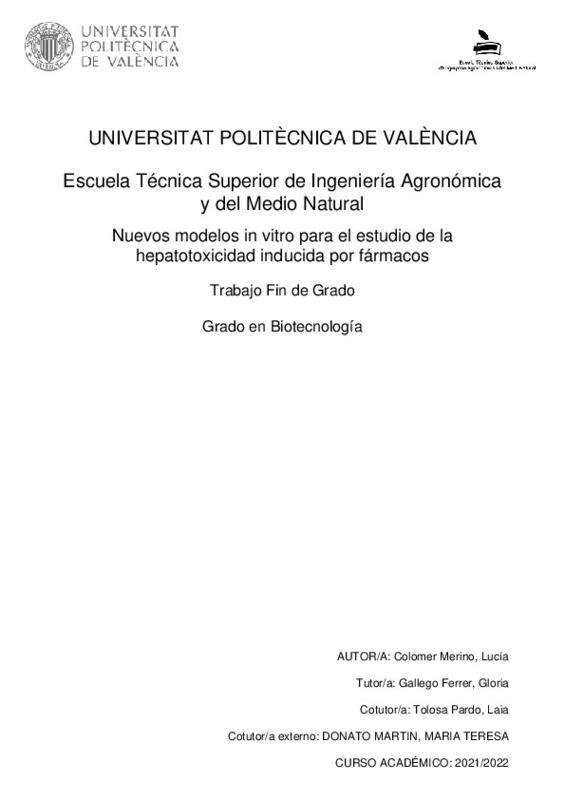JavaScript is disabled for your browser. Some features of this site may not work without it.
Buscar en RiuNet
Listar
Mi cuenta
Estadísticas
Ayuda RiuNet
Admin. UPV
Nuevos modelos in vitro para el estudio de la hepatotoxicidad inducida por fármacos
Mostrar el registro sencillo del ítem
Ficheros en el ítem
| dc.contributor.advisor | Gallego Ferrer, Gloria
|
es_ES |
| dc.contributor.advisor | Tolosa Pardo, Laia
|
es_ES |
| dc.contributor.advisor | Donato Martín, María Teresa
|
es_ES |
| dc.contributor.author | Colomer Merino, Lucía
|
es_ES |
| dc.date.accessioned | 2022-10-20T09:11:05Z | |
| dc.date.available | 2022-10-20T09:11:05Z | |
| dc.date.created | 2022-09-28 | |
| dc.date.issued | 2022-10-20 | es_ES |
| dc.identifier.uri | http://hdl.handle.net/10251/188363 | |
| dc.description.abstract | [EN] Drug-induced liver injury (DILI) is a multifactorial patient-specific pathophysiological process that cannot be recapitulated in current in vitro models. DILI is one of the main reasons for drug withdrawal the development process and in the clinical practice; thus, it is necessary to create new holistic approaches that are predictive of DILI. Since multiple mechanisms and cell types have been implicated, prediction of all forms of DILI can be difficult with simple strategies such as two-dimensional monocultures. Classic strategies have been based on the use of primary human hepatocytes or hepatoma cell lines, but the role of non-parenchymal cells in DILI, mainly in idiosyncratic hepatotoxicity, has been also recognized. In this sense, Kupffer cells are liver resident macrophages with phagocytic functions. This project aims to develop and characterize different co-culture systems that combine liver cells (HepG2) and macrophages isolated and differentiated from peripheral blood or obtained from the differentiation of the monocyte cell line THP-1 to carry out hepatotoxicity studies. In this project, the models have been optimized, studying different proportions of cells and culture media, and using different Cellular and Molecular Biology techniques (qPCR, immunofluorescence...) to characterize the developed models. In the system selected as optimal, hepatotoxicity induced by a model drug (troglitazone) has been studied, demonstrating the suitability and sensitivity of co-cultures for the evaluation of drug-induced liver damage. | es_ES |
| dc.description.abstract | [ES] El daño hepático inducido por fármacos (DILI) es un proceso fisiopatológico multifactorial específico de paciente que no se puede recapitular en los modelos in vitro actuales. El DILI es una de las principales razones de retirada de fármacos en desarrollo y en la práctica clínica, por lo que es necesario crear nuevas aproximaciones holísticas que sean predictivas del mismo. Dado que se han implicado múltiples mecanismos y tipos celulares, la predicción de todas las formas del DILI puede ser difícil con estrategias simples como los monocultivos bidimensionales. Las estrategias clásicas se han basado en el uso de hepatocitos humanos primarios o líneas celulares de hepatoma, pero también se reconoce el papel de las células no parenquimáticas en DILI, principalmente en la hepatotoxicidad idiosincrásica. En este sentido, las células de Kupffer son macrófagos residentes en el hígado con funciones fagocíticas que desempeñan un papel importante. El presente proyecto pretende desarrollar y caracterizar distintos sistemas de co-cultivo de células hepáticas (HepG2) y macrófagos aislados y diferenciados a partir de sangre periférica, o bien obtenidos a partir de la diferenciación de la línea celular de monocitos THP-1 para realizar estudios de hepatotoxicidad. En este trabajo se han puesto a punto los modelos, estudiando diferentes proporciones de células y medios de cultivo y usando diferentes técnicas de Biología Celular y Molecular (qPCR, inmunofluorescencia¿) para caracterizar los sistemas desarrollados. En el modelo seleccionado como óptimo se ha estudiado la hepatotoxicidad inducida por un fármaco modelo (troglitazona), demostrando la idoneidad y sensibilidad de los co-cultivos para la evaluación del daño hepático inducido por fármacos. | es_ES |
| dc.format.extent | 42 | es_ES |
| dc.language | Español | es_ES |
| dc.publisher | Universitat Politècnica de València | es_ES |
| dc.rights | Reconocimiento - No comercial - Compartir igual (by-nc-sa) | es_ES |
| dc.subject | Hepatotoxicidad | es_ES |
| dc.subject | Modelos in vitro | es_ES |
| dc.subject | Co-cultivo | es_ES |
| dc.subject | Hepatocitos | es_ES |
| dc.subject | Macrófagos | es_ES |
| dc.subject.classification | MAQUINAS Y MOTORES TERMICOS | es_ES |
| dc.subject.other | Grado en Biotecnología-Grau en Biotecnologia | es_ES |
| dc.title | Nuevos modelos in vitro para el estudio de la hepatotoxicidad inducida por fármacos | es_ES |
| dc.title.alternative | Nous models in vitro per a l estudi de l'hepatotoxicitat induïda per fàrmacs | es_ES |
| dc.title.alternative | New in vitro models for the study of drug-induced hepatotoxicity | es_ES |
| dc.type | Proyecto/Trabajo fin de carrera/grado | es_ES |
| dc.rights.accessRights | Abierto | es_ES |
| dc.contributor.affiliation | Universitat Politècnica de València. Departamento de Termodinámica Aplicada - Departament de Termodinàmica Aplicada | es_ES |
| dc.contributor.affiliation | Universitat Politècnica de València. Escuela Técnica Superior de Ingeniería Agronómica y del Medio Natural - Escola Tècnica Superior d'Enginyeria Agronòmica i del Medi Natural | es_ES |
| dc.description.bibliographicCitation | Colomer Merino, L. (2022). Nuevos modelos in vitro para el estudio de la hepatotoxicidad inducida por fármacos. Universitat Politècnica de València. http://hdl.handle.net/10251/188363 | es_ES |
| dc.description.accrualMethod | TFGM | es_ES |
| dc.relation.pasarela | TFGM\150518 | es_ES |
Este ítem aparece en la(s) siguiente(s) colección(ones)
-
ETSIAMN - Trabajos académicos [3543]
Escuela Técnica Superior de Ingeniería Agronómica y del Medio Natural






